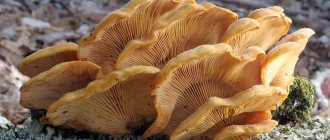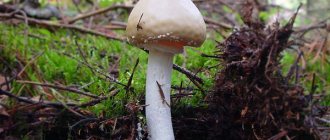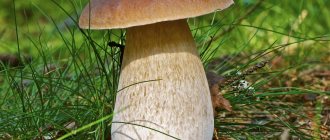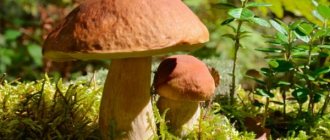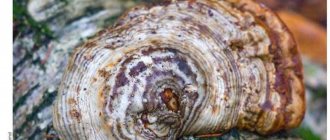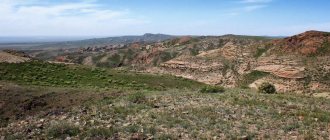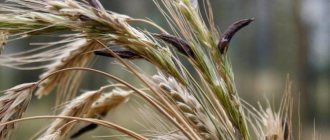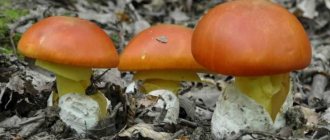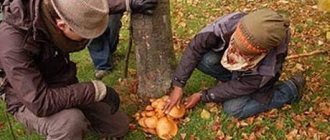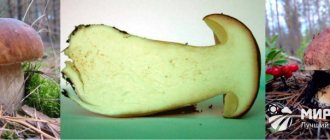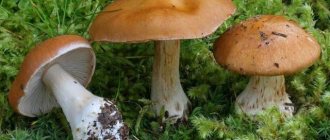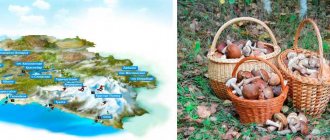Short description
| Type of mushrooms: | edible |
| Other names (synonyms): | – |
| Latin name: | Pleurotus dryinus |
| Family: | Oyster mushrooms (Pleurotaceae) |
| Distinctive feature: | Oyster mushroom grows on dead wood and is also a mild pathogen, infecting broad-leaved trees. |
| Beginning of the season: | July |
| End of season: | September |
| Leg height (cm): | 2-6 cm |
| Cap width (cm): | 4-15 (20) cm |
| Smell: | spicy |
| Taste: | soft, nutty |
| Tasting score: | [kkstarratings] Have you tried this mushroom? Then rate it! |
| Hat: | convex, later becomes widely convex; round in contour. White to pale greyish in color, often yellowing with age, often with remnants of a spathe along the edge. |
| Leg: | cylindrical or slightly thickening downwards, central, eccentric or even lateral, velvety, whitish, with a filmy or cottony ring, usually disappearing as the mushroom ages. |
| Hymenophore (bottom of cap): | the plates are initially white, later becoming creamy to yellowish, wide, some of them forked. |
| Disputes: | cylindrical and sometimes elliptical in shape, 9.8-13.9 x 3.8-4.2 microns. |
| Pulp: | thick, hard, whitish, yellowed with age. |
| Natural environment and mycorrhiza: | on dead wood, and may also be a weak tree parasite. This occurs especially on oak (from which it takes its name), but also on beech, other broad-leaved trees, and sometimes conifers. |
| False doubles: | The oak oyster mushroom is distinguished by its characteristic private veil. Knowing this, it is impossible to confuse oak oyster mushroom with pulmonary or oyster mushroom. |
| Growing: | – |
| Use: | Only young ones are edible; in older ones, the flesh becomes hard and tasteless. |
| Medicinal properties: | contains a large amount of polysaccharides, due to which this mushroom is considered an anti-cancer product. |
| Spreading: | throughout Europe, also found in North America. |
The civilization of mushrooms is widespread throughout the planet. It is important to learn to distinguish edible species from poisonous ones. In doubtful cases, do not use the mushroom in cooking.
Oyster mushroom (Pleurotus ostreatus)
Synonyms:
Oyster mushroom or oyster mushroom is the most cultivated representative of the oyster mushroom genus. It is extremely convenient for cultivation due to its unpretentiousness to climatic conditions and tenacious mycelium, suitable for storage.
Oyster mushroom cap: Round-eccentric, funnel-shaped, ear-shaped, usually with rolled-up edges, matte, smooth, can take on any shades ranging from light ash to dark gray (there are light, yellowish, and “metallic” options). Diameter 5-15 cm (up to 25). Several caps often form a fan-shaped, multi-tiered structure. The pulp is white, dense, and becomes quite tough with age. The smell is weak, pleasant.
Oyster mushroom plates: Descending along the stalk (the stalk, as a rule, does not reach the base), sparse, wide, white in youth, then grayish or yellowish.
Spore Powder: White.
Leg of oyster mushroom: Lateral, eccentric, short (at times almost invisible), curved, up to 3 cm in length, light, hairy at the base. Older oyster mushrooms are very tough.
Distribution: Oyster mushroom grows on dead wood and weakened trees, preferring deciduous trees. Mass fruiting, as a rule, is observed in September-October, although under favorable conditions it may appear in May. Oyster mushroom bravely fights frosts, leaving behind almost all edible mushrooms, except for the winter honey fungus (Flammulina velutipes). The “nest” principle of the formation of fruiting bodies actually guarantees high yields.
Similar species: The oyster mushroom can, in principle, be confused with the oyster mushroom (Pleurotus cornucopiae), from which it differs in a stronger constitution, a darker color of the cap (except for light varieties), a short stalk and plates that do not reach its base. The oyster mushroom is also distinguished from the whitish oyster mushroom (Pleurotus pulmonarius) by its dark color and more solid structure of the fruiting body; from oak oyster mushroom (P. dryinus) - absence of a private cover. Inexperienced naturalists may also confuse the oyster mushroom with the so-called autumn oyster mushroom (Panellus sirotinus), but this interesting mushroom has a special gelatinous layer under the skin of the cap that protects the fruiting body from hypothermia.
Edibility: The mushroom is edible and even tasty when young. Artificially cultivated (everyone who goes to the store has seen it). Older oyster mushrooms become tough and tasteless.
Video about the Oyster mushroom:
Author's notes: Surprisingly, but true: I first encountered the most common oyster mushroom only when I wanted it myself. Consciously collided. I remembered at the beginning of September that I had never actually seen oyster mushrooms in the field (shame!), and went in search
It took a long time to search: only on the way back, passing by a huge broken willow tree growing (or rather, rotting) at my gate, did I notice strange gray “ears” provocatively bristling on the chopped trunk...
Unlike its inconspicuous counterparts, the oyster mushroom made a very serious impression on me. She doesn't look like a dried-out pig's ear or a puffy, overgrown fox. Heavy “nests” that do not fall apart when collected, large cozy burdock caps, dense white pulp, homerically huge worms... all these signs set one in a serious mood. In fact, not every mushroom knows how to present itself in such a way that you want to grab the whole “nest” (with two hands, you can’t drag it away with one) and take it to show the neighbors - which is exactly what I did.
And oyster mushroom nests are also able to cunningly twist out from under a knife and fall with all their weight onto the head of a hasty collector, without splitting at all.
Edible representatives of the forest kingdom
When going into a dense thicket on a “silent hunt”, a mushroom picker must be absolutely sure that he will not make a mistake in choosing the fruits that can be eaten. And if an inexperienced collector has ever heard that the crop we are considering develops and bears fruit on the trunks of fallen or dying trees, then in reality this information is not enough. Not everyone will be able to accurately distinguish edible mushrooms from false ones. It is worth noting that in our country there are no overtly poisonous, deadly members of the family, but there are still inedible ones. They're enough to give you nasty food poisoning.
To protect yourself and your loved ones from unpleasant health problems, you need to know how to recognize the edible variety of oyster mushroom, also called oyster or common:
- The fruit of the oyster mushroom has a massive, dense, round cap with wavy edges. The color is light gray, sometimes with a slight purple or yellow tint (depending on the tree on which the fruiting body grows). The optimal size is 4 – 26 centimeters in diameter. The surface is smooth, slightly moisturized, not slimy, reminiscent of velvet.
- The pulp is fleshy, juicy, and quite tender. The older the representative, the coarser the fibers become.
- The leg is so small that it is practically invisible from behind the head of the mushroom. Smooth, light cream shades. It is eaten only at a young age, because as it grows it becomes tough and tasteless.
The delicacy is in demand among housewives who love to eat delicious food. Suitable for various types of processing - oyster mushrooms are pickled, pickled, fermented, canned, dried, stewed, fried and even boiled (with subsequent freezing). In addition, the fruits of the plant are popular among traditional healers - it is believed that the tasty pulp can prevent the formation of tumors. Classical medicine also uses it as an ingredient in pharmaceuticals.
The culture is often found in deciduous forests, sometimes in coniferous forests. It grows in all regions of the Russian Federation, Ukraine and Belarus.
There are several more edible brothers of the species - steppe, royal, pulmonary and carob. We’ll talk about them another time, since the listed fruits are rarely found, and they are not particularly popular.
Oak oyster mushroom (Pleurotus dryinus): description and photo
| Name: | Oyster mushroom |
| Latin name: | Pleurotus dryinus |
| Type: | Conditionally edible |
| Characteristics: |
|
| Taxonomy: |
|
Oak oyster mushroom is a rare conditionally edible mushroom of the Oysteraceae family. In several regions of Russia it is included in the Red Book.
Where does oak oyster mushroom grow?
Despite its name, it settles not only on the remains of oaks, but also on the dead wood of other deciduous trees, such as elms. Mushrooms are found in mixed and deciduous forests of the temperate zone of the European continent. Grows singly or in clumps, often multi-layered, and can completely cover a dead tree.
A description and photo of oak oyster mushroom is presented below.
What does oak oyster mushroom look like?
The cap has a shell-shaped or fan-shaped, convex or concave-prostrate shape. It reaches 5-10 cm in diameter, sometimes 15 cm. The edge curls inward. The surface is smooth, with pressed scales, white, cream, gray or brownish. The pulp is light, elastic, thick, and has a pleasant mushroom smell.
This mushroom grows singly or grows together with its roots into small bundles.
The plates are quite wide, frequent, branched, and descending. Their edge is smooth, wavy or finely toothed. The color is lighter than that of the cap, becoming yellowish with age. Covered with a white or light gray coating. White spore powder.
The height of the leg is from 3 to 5 cm, thickness is from 1 to 3 cm. It is eccentric, short, and tapers towards the base. The color is like a hat, sometimes a little lighter. The pulp is yellowish, hard and fibrous closer to the root.
The young oak oyster mushroom has a cover on its plates. It quickly ruptures and turns into white and brownish patches on the cap and a torn flake-like ring on the stem.
Is it possible to eat oak oyster mushroom?
It is considered conditionally edible. In some foreign sources it is described as an inedible species, in others - as a mushroom with good taste.
False doubles
Oyster mushroom, or common oyster mushroom. This species has a similar fruit body shape, size and color. Its main difference is the absence of a cover on the plates. The stalk is short, eccentric, lateral, curved, often inconspicuous, hairy at the base, and very hard in older specimens. It is classified as edible, grown on an industrial scale, and is the most cultivated species among oyster mushrooms. Unpretentious, adapts well to unfavorable conditions. Active growth is observed in September-October; fruiting can begin even in May. High yields are ensured by the fact that the fruiting bodies grow together, forming so-called nests.
Oyster mushrooms grown in artificial conditions can be bought in any supermarket
Oyster mushroom (whitish, beech, spring). The color of this mushroom is lighter, almost white. Another important sign is the absence of a filmy cover. The leg is lateral, less often central, hairy at the base, dirty white. Classified as edible. It grows from May to September on rotting wood, less often on living but weak trees. Under good conditions, the bases grow together into bundles. Occurs infrequently.
Oyster mushroom is white in color
Rules for collection and use
Oyster mushrooms can be harvested from July to September.
It is quite rare, and there is little information about its taste. There is an opinion that this one is not inferior in taste to its widespread relative - the oyster (ordinary). You can fry, stew, dry, prepare soups and sauces. As a rule, only the caps are eaten, since the legs have a fibrous structure and are rigid.
Before cooking, boil for 20 minutes in salted water. It is not recommended to salt or pickle for long-term storage as canned food.
Conclusion
Oak oyster mushroom is a rare conditionally edible mushroom. Its main difference from other related species is the presence of a veil on the spore-bearing layer, which in adult specimens breaks and presents remains in the form of flakes.
Speckled oakberry - a mushroom with beneficial properties
Speckled oakweed is a representative of the Boletaceae family. It is also called red-footed boletus, red-legged boletus, granular-legged boletus, granular-legged boletus, granular-legged boletus, and bruise. This is a conditionally edible mushroom.
Description of speckled oak
The shape of the cap is cushion-shaped or hemispherical. Its diameter is 5-20 centimeters. The surface of the cap is velvety and matte to the touch, but in rare cases it can be slimy.
In older specimens, the caps may become bare. The color of the cap is dark brown, black-brown, chestnut brown, dark brown, and a reddish or olive tint may be observed.
If you press on the cap, it becomes darker or bluish.
The pulp is bright yellow or yellowish. A distinctive feature of speckled oak is that a fresh cut of the flesh turns blue or greenish-blue after a few seconds. The pulp in the stem is brownish or reddish in color and has no smell or taste.
The stem is tuberous, cylindrical or barrel-shaped, and most often thickens at the base over time. Its length is 5-15 centimeters, and its thickness ranges from 1.5 to 4 centimeters. The color of the leg is yellow-red, there is no mesh pattern, but red dots or scales are noticeable.
Places of growth of speckled oaks
Speckled oak trees grow next to spruce, fir, beech and oak trees; they form mycorrhizae with deciduous and coniferous trees. These mushrooms prefer to settle in acidic soils. They can be found in marshy areas and among mosses.
Speckled oaks are common in Europe, the Caucasus and Eastern Siberia, but in the Far East and Western Siberia they are much less common. In the European part of Russia, speckled oak trees are not often found. They bear fruit from May to October.
Eating speckled oaks
Speckled oakberry, as noted, belongs to the category of conditionally edible mushrooms. The flesh of these mushrooms is fleshy and aromatic. After heat treatment, oak leaves retain their beneficial properties; in addition, they practically do not boil down.
They are used for food after boiling for 15 minutes, the broth is drained, then sauces and side dishes can be prepared from them. The good taste of oak mushrooms is revealed when fried; many people like the aroma of fried mushrooms and their taste. Some people prefer salted oak. Pickled oakberries are also very tasty. Speckled oak trees are also suitable for drying.
Similar species
Among edible mushrooms, the following species have an external resemblance to speckled oak mushrooms:
- The yellow boletus is distinguished by the fact that its entire fruiting body is yellow-brown. In addition, this species is found exclusively in Western Europe;
- Olive-brown dubovik differs from dubovik by the speckled presence of a mesh pattern on the stem;
- Kele's oakberry has a lighter yellow-brown cap. These mushrooms grow on calcareous soil. This is a rare species.
Speckled oak mushroom can also be confused with a poisonous species - the satanic mushroom. This poisonous mushroom can be recognized by its pulp; at first its color turns red when cut, and only after that it begins to turn blue; in addition, it has a sharp, unpleasant odor.
The benefits of speckled oak trees
Like many mushrooms, speckled oaks boast a large number of useful qualities. They are rich in microelements important for the body - manganese, zinc and copper.
Zinc normalizes the activity of the digestive system. This element accumulates in the pancreas and helps in the absorption of nutrients and digestion of foods.
Copper takes part in the formation of blood cells, in the formation of pituitary hormones and in metabolism.
In addition, speckled oaks contain beta-glucans, which have a positive effect on the immune system. These substances actively fight the formation of malignant tumors.
Oak trees also contain amino acids that make memory stronger, enhance mental activity, and normalize coordination of movement. When consuming speckled oak, the risk of developing atherosclerosis is reduced.
Use speckled oak with caution
Oak mushrooms, like other mushrooms, are specific foods. They contain natural chitin, which is good for health, but children do not absorb chitin, so this food is heavy for them. It is not recommended to give speckled oaks to children under 12 years of age.
Popular and common
Buyers who come to the supermarket to buy mushrooms are first greeted by Oyster mushrooms. They literally filled retail outlets. Many private entrepreneurs and large mushroom growing farms have mastered the method of artificially growing these mushrooms. They are prolific and unpretentious. However, in terms of taste, cultivated Oyster mushroom is significantly inferior to varieties that grow in nature; it has almost no characteristic mushroom aroma.
For amateurs who do not understand mushrooms, Oyster mushrooms are ideal. They are edible and tasty; poisonous counterparts do not exist in nature. Beginners just need to study the photos and names of the varieties of Oyster mushrooms - and it’s time to go on a quiet hunt. Do you want to know exactly what kind of mushroom you came across in the forest? Then carefully read the description; the mushroom encyclopedia contains detailed verbal portraits of mushrooms, valuable information about beneficial properties, and methods of preparation.
Once in a forest or park, inspect the trunks of living and fallen trees, stumps and dead wood. Oyster mushroom is a common tree mushroom that grows even in gardens on weakened, diseased fruit trees. Discovering a whole family is a matter of time, don’t rush, be careful, a reward awaits the patient mushroom picker. Edible mushrooms on trees are a great success for the collector. Almost all types of Oyster mushrooms grow in large families weighing from 1 to 3 kg. If you find one of these, a lucky mushroom picker will find a full frying pan of delicious fried mushrooms. Don't be alarmed if you see pink, orange, olive, yellow mushrooms on tree trunks; these are edible varieties of Oyster mushrooms.
Description
Oak oyster mushroom (Pleurotus dryinus) is edible and belongs to the Oyster family. It is marked by the following species characteristics:
- the cap is “oyster” shaped, with a rolled edge, initially convex, becoming flatter as it develops. The color is whitish, and may acquire a more or less pronounced light brownish tint. The surface is rough, with small scales that become darker and more noticeable with age. Cap diameter up to 10 cm;
- the descending plates are quite frequent, lighter in color than the cap and stem. With age they acquire a yellowish tint. In young mushrooms, the plates are completely covered with a light protective blanket. Remnants of this cover persist into adulthood;
- spores are grayish-white;
- the leg is eccentric, rigid at the base, often lateral, sometimes very short or completely absent; On average, its dimensions are up to 5 cm in length, 1-3 cm in thickness. The color matches the tone of the cap, but may be somewhat lighter; dense, scaly, with a rapidly disappearing cover;
- light, dense, fleshy pulp with a slight mushroom smell is pleasant to the taste.
Cooking recipes
Oak oyster mushroom is easily processed for preparing various dishes.
Cleaning
Mushrooms are filled with water for 15–20 minutes. Remove from the container and remove any adhering debris. Using a thin sharp knife, dry and spoiled areas are removed and the roots are removed. Wash the cleaned mushrooms again.
Cooking
Mushrooms are placed in cold water, salt is added. When cooked, oyster mushrooms release juice abundantly, so the water should barely cover the mushrooms. You can add a little pepper and a clove of garlic. Boil the mushrooms for 15-20 minutes over medium heat. Use a colander to allow excess liquid to drain over the sink. The oyster mushrooms are cooked!
Pickling
The recipe allows you to marinate mushrooms in just 8 hours.
You will need:
- fresh oyster mushrooms – 1 kg;
- sugar – 2 tbsp. l.;
- salt – 1 tsp;
- onions – 2 large heads;
- garlic – 2 cloves;
- vinegar 9% – 30 ml;
- water – 0.5 tbsp.
The washed mushrooms are cut into pieces, small oyster mushrooms are left whole. Boil in salted water for 15 minutes, while preparing the marinade. Stir salt and sugar until dissolved, add vinegar and add chopped garlic cloves. Peeled onions are cut into thin half rings and crushed to release the juice.
Place half of the onion in a prepared marinating container and a layer of oyster mushrooms on top. Fill with marinade, cover with the remaining onions and press down with pressure. The further cooking process continues in the refrigerator.
Freezing
Peel and rinse the mushrooms, place on a paper towel, cut into small pieces and let dry on the towel again. Place the oyster mushrooms on a flat surface and place in the freezer for 4 hours. This action will prevent the mushrooms from sticking together. Transfer to bags and return to freezer.
Frying
Peeled oyster mushrooms are cut into pieces and placed in a frying pan with heated sunflower oil. Add salt and fry until all the liquid has evaporated.
Pickling
You will need:
- rock salt - 60 g;
- cloves - 3 buds (inflorescences);
- garlic - 3 cloves;
- dill sprigs with umbrellas - 2 pcs.;
- bay leaf - 1 leaf;
- allspice - 4 pcs.;
- black pepper - 4 pcs.;
- filtered water (for brine) - half a liter.
Separate the legs, leaving the cap with a centimeter-long part of the base. Blanch for about 7 minutes and allow to drain. The caps are placed in dry, sterilized jars in dense layers.
To prepare the brine, pour rock salt into boiling water (0.5 liters), add peppers, clove buds, and laurel. leaf, dill sprigs, peeled whole cloves of garlic. Boil for 7 minutes and strain the brine. Pour into jars and close with nylon lids. After a week the product is ready to eat.
Canning oyster mushrooms for the winter
Required:
- oyster mushrooms – 500 g;
- champignons – 500 g;
- large carrots – 2 pcs.;
- garlic – 3 cloves.
Cook the mushrooms for 8 minutes, adding salt to the water. Allow to drain through a sieve. Larger mushrooms are divided into parts, the carrots are grated on a fine grater and mixed with the mushrooms. For the marinade, pour 4 tablespoons of vegetable oil into the frying pan, add 1 tsp. chopped paprika, ¼ spoon of chopped black pepper, red pepper to taste. All ingredients are quickly fried. To the mushrooms and carrots add finely chopped garlic, 3 tbsp. l. vinegar. You can add a little sugar, spices are poured into a container with mushrooms. After mixing, pour into jars.
Each individual type of mushroom has its own individual composition, taste, and appearance. Oyster mushroom is widely used in preparing delicacies and is valued for its beneficial qualities.
Places where oak oyster mushroom grows
Although this oyster mushroom is called oak, it bears fruit on the remains of a variety of trees. They are collected from July to September, at the same time when the pulmonary oyster mushroom bears fruit.
Distinctive features of oak oyster mushroom
The oak oyster mushroom can be recognized by its characteristic veil. It is by this feature that the oak oyster mushroom can be easily distinguished from the oyster and lung oyster mushrooms.
Evaluating the edibility of oak oyster mushroom
In foreign literature, oak oyster mushroom appears as an inedible mushroom, but certain sources note that it has good nutritional qualities. However, this type of mushroom is not widespread, so it is difficult to judge its taste.
Properly prepared oyster mushrooms taste no worse than their forest relatives - boletus, boletus and porcini mushrooms. Oak oyster mushrooms, like other varieties of oyster mushrooms, are universal; they can be stewed, salted, boiled, fried, pickled, and prepared into sauces and soups. Oyster mushroom goes well with poultry and meat.
It should be noted that oyster mushrooms cannot be stored for a long time. They are quick to cook and do not require pre-cleaning, like many other types of mushrooms. The caps of oyster mushrooms are mainly used for food, and the legs are used less frequently because they are fibrous and tougher. But the legs can be finely chopped, and then they will become more tender. If oyster mushrooms complement dishes, then they are added almost at the end of the cooking process.
When boiling oyster mushrooms, they are cut and dipped in salted, boiling water, after which they are boiled for about 20 minutes. Before marinating, they are boiled with spices and vinegar for 25 minutes. Like other mushrooms, oyster mushrooms go well with onions. When frying, you can use vegetable oil and butter. Fried, boiled or pickled mushrooms are added to salads.
The benefits of oyster mushrooms for the body.
Oak oyster mushrooms contain a large amount of polysaccharides, due to which they are considered an anti-cancer product. These mushrooms have an immunomodulatory effect, so they are detrimental to benign and malignant neoplasms. It is recommended to consume oyster mushrooms after chemotherapy or exposure to radiation. These mushrooms remove toxins from the body. Today, a large number of medicines have been developed based on oyster mushrooms to fight cancer cells.
Oyster mushrooms contain almost all B vitamins, vitamins C, E, PP, iodine and iron. They are also rich in essential amino acids, easily digestible proteins, monounsaturated fats and minerals. In addition, oyster mushrooms contain iron, phosphorus, copper, cobalt, zinc, calcium and selenium; without these minerals, human vital functions cannot function.
Oak oyster mushrooms have the following positive effects on the body:
- Prevents the risk of developing gastric and intestinal ulcers;
- Suppress the development of hypertension and hypotension;
- Destroy E. coli;
- Inhibits the development of atherosclerosis;
- Reduce blood glucose levels;
- Remove cholesterol;
- Cleanse the body of parasites;
- Restore metabolism;
- Ensure normal functioning of the heart and blood vessels.
Due to the high protein content in oyster mushrooms, these mushrooms are equated to meat and dairy products. At the same time, they contain little fat, so they are a good dietary product.
Harm of oak oyster mushrooms to the body.
Although oyster mushrooms have good taste and medicinal properties, they can still cause harm to the body. Basically, individual intolerance and allergic reactions can be observed. Eating these mushrooms can cause heaviness in the stomach, and they can also cause bloating and diarrhea.
Since oyster mushrooms are difficult to digest, older people and children should take them with caution. It is not recommended to eat oyster mushrooms more than twice a week
You should also know that oyster mushrooms contain chitin, which is not digested in the body, therefore, these mushrooms should be subjected to good heat treatment. They are boiled before salting and pickling.
Reception of oyster mushrooms should be limited or completely eliminated in the presence of diseases of the kidneys, liver, digestive tract and pancreas.
However, there are negative aspects to this growing option.
Anyone who has thought about the question of how to grow oyster mushrooms has probably encountered the problem of the need for large initial investments and the use of large premises based on a special microclimate.
Technologically, this mushroom requires the creation of special myceliums for the process of planting and high-quality growth.
Lemon oyster mushroom
Ilmak
Lemon oyster mushroom (Pleurotus citrinopileatus) is a cap mushroom from the Ryadovkov family, belongs to the genus Pleurotus (Pleurotus, Oyster mushroom).
External description
Lemon oyster mushroom (Pleurotus citrinopileatus) is a variety of ornamental and edible mushrooms, the fruiting body of which consists of a stem and a cap. It grows in groups, and individual specimens grow together, forming a beautiful lemon-colored mushroom cluster.
Mushroom pulp is white and smells like flour. In young specimens it is soft and tender, but in mature mushrooms it becomes rough.
The stem of the mushroom is white (yellow in some specimens) and comes from the central part of the cap. In mature mushrooms it becomes lateral.
The diameter of the cap is 3-6 cm, but in some specimens it can reach 10 cm. In young mushrooms, the cap is thyroid-shaped, in mature fruiting bodies a large depression appears on it, and a little later the cap becomes funnel-shaped, and its edges become lobed. The bright lemon color of the cap of overripe, old mushrooms fades and acquires a whitish tint.
The lamellar hymenophore consists of frequent and narrow plates, the width of which is 3-4 cm. They are slightly pinkish in color, descending onto the stem in the form of lines. The spore powder is white, but in many specimens it has a pink-violet tint.
Season and habitat of the mushroom
Lemon oyster mushroom (Pleurotus citrinopileatus) grows in the southern part of the Primorsky Territory, in mixed forests (with coniferous and broad-leaved trees), on living or dead elms. This fungus also develops well on elm dead wood, and in the northern regions and middle plant zone it is also found on birch trunks. Lemon oyster mushrooms are widespread in the southern parts of the Far East, are well known to the local population there and are used by them as edible mushrooms. It begins to bear fruit in May and ends in October.
Edibility
Lemon oyster mushroom (Pleurotus citrinopileatus) is an edible mushroom. It has good taste and is consumed salted, boiled, fried and pickled. Lemon oyster mushrooms can be dried. However, in ripe fruiting bodies, only the cap is suitable for consumption, since the stem of the fruiting body becomes fibrous and rough. In some specimens, the part of the cap above the stem is also endowed with such qualities, so it also has to be cut out before preparing the mushrooms for food. It is grown under artificial conditions for the purpose of sale.
Other information about the mushroom
This oyster mushroom was called lemon yellow for the characteristic color of the cap, similar to the color of a ripe lemon. The mushroom retains its bright yellow color throughout its growth. The substrate mycelium of lemon oyster mushroom is resistant to cold and frost. The mushroom itself is heat-loving, has medium-strength taste properties, and becomes a real decoration for the garden.
lemon oyster mushroom
from questions in recognition:
How to make oyster mushroom mycelium: growing it at home with your own hands
Oyster mushroom mycelium is the vegetative body of the fungus, mycelium, which consists of thin branched threads. Usually develops in the substrate or on its surface. There are several ways to obtain it, both in the laboratory and at home.
In nature, mushrooms reproduce primarily by spores. However, science does not stand still, and it was decided to learn how to grow mushrooms in artificially created conditions.
Previously, to grow oyster mushrooms in the forest, they took mycelium and propagated it in adapted greenhouses. At the same time, a small piece of it was planted on previously prepared soil, without sprinkling soil on top, so that the mycelium would not bear fruit. When all the soil was well intertwined with mycelium, it was taken out, slightly dried and used for dilution. In Russia, oyster mushroom mycelium was obtained in this way in the late thirties of the twentieth century.
The quality of the mycelium obtained under such conditions was low. Fruiting was scanty, and the mycelium quickly degenerated. When using such oyster mushroom mycelium, harmful bacteria and microorganisms were introduced, which inhibited development and deteriorated quality. Therefore, researchers were constantly looking for new technology for growing mycelium.
In 1894, in one of the institutes in France, mycelium was first bred from fungal spores grown in laboratory conditions. It had great prospects, since it took root much better and brought an extensive harvest before the mushrooms appeared in the forest. But spore breeding was successful only in laboratory conditions, which significantly reduced the frequency of its use.
The last to be patented was a method for growing oyster mushroom grain mycelium. In modern Russia it is still widely used. Mushroom growers grow mycelium on the grain of any type of cereal crop, as well as on sunflower shells, dry grape pomace, corn stalks, and sawdust.
The highest quality mycelium is obtained in laboratory conditions, but how can you prepare it at home yourself? If you do not have the equipment to organize the work of a scientific laboratory, then production at home can be carried out where there is gas, water and electricity.
You can prepare mycelium for growing oyster mushrooms at home, but before doing this, you need to purchase special equipment: test tubes, tweezers, thermometer, pipettes, agar.
At the stage of preparing the room and equipment, it is necessary first of all to take into account the fact that there are from 5,000 to 20,000 microorganisms per 1 m2. And the primary task for the mushroom grower is to resolve the issue of how to prepare sterile equipment and ensure workplace hygiene.
There are two ways to grow oyster mushroom mycelium at home. The first method is the full cycle. From spores or a piece of the fruiting body, a mother culture is grown, from which intermediate mycelium can be obtained and seed mycelium can be grown.
The second shortened method is the propagation of mycelium purchased from specialists.
Video: DIY royal mycelium
Oyster mushroom mycelium can be grown on grain or wood at home. Grain mycelium is obtained by applying mother cultures to a substrate of cereal grains. This type of production is more common.
In the second case, the mycelium is located on wooden sticks. This type is suitable when mushroom production on stumps is used. Mycelium grown on wood is less susceptible to diseases and has a long shelf life.
